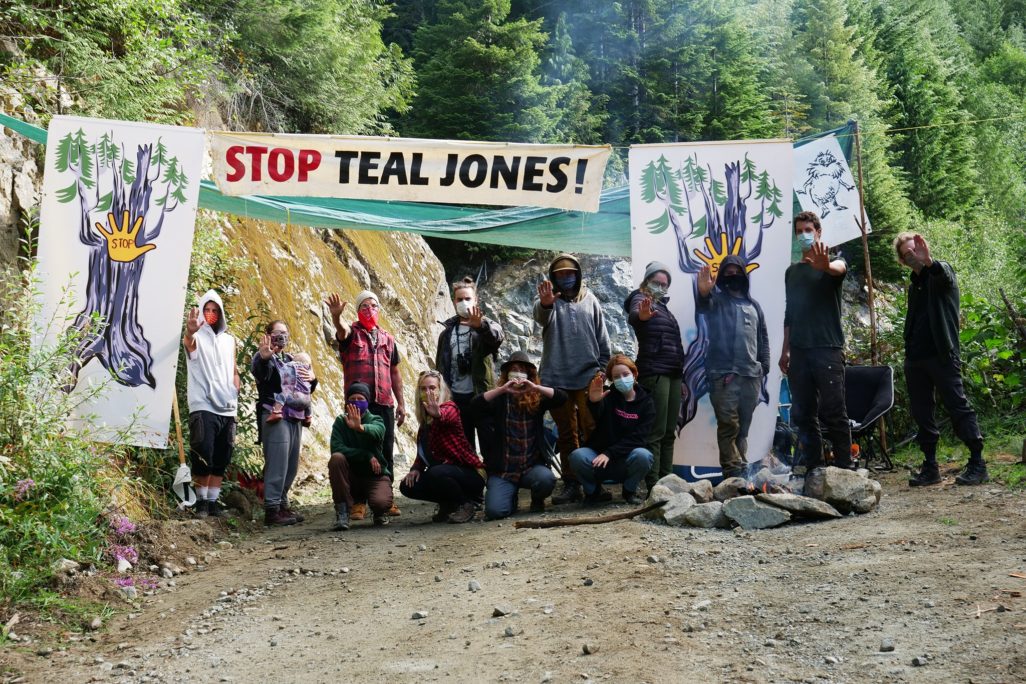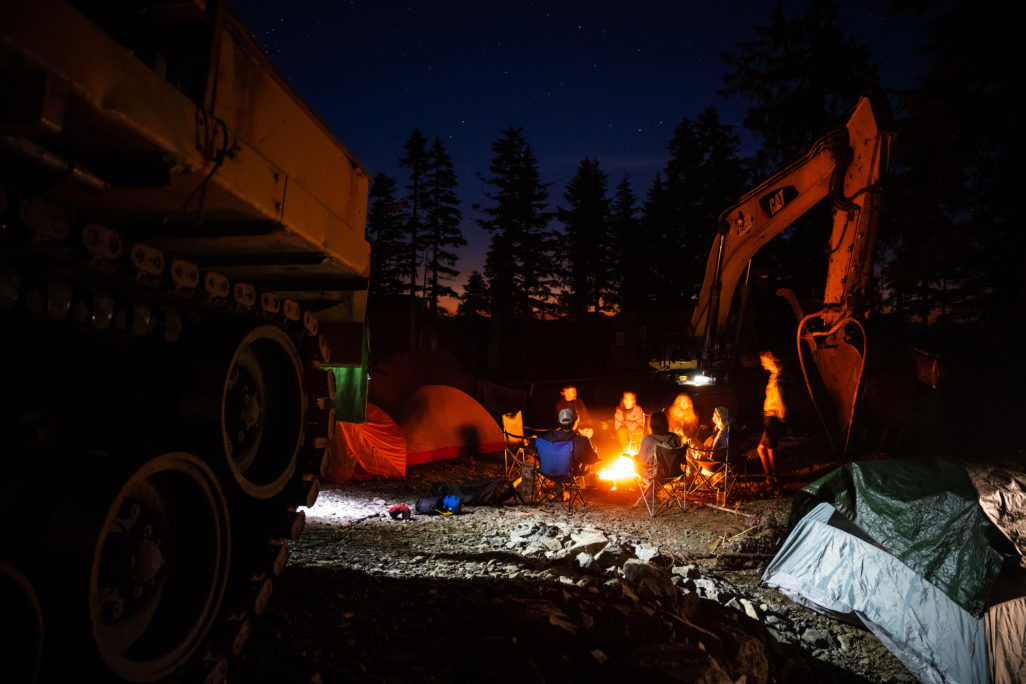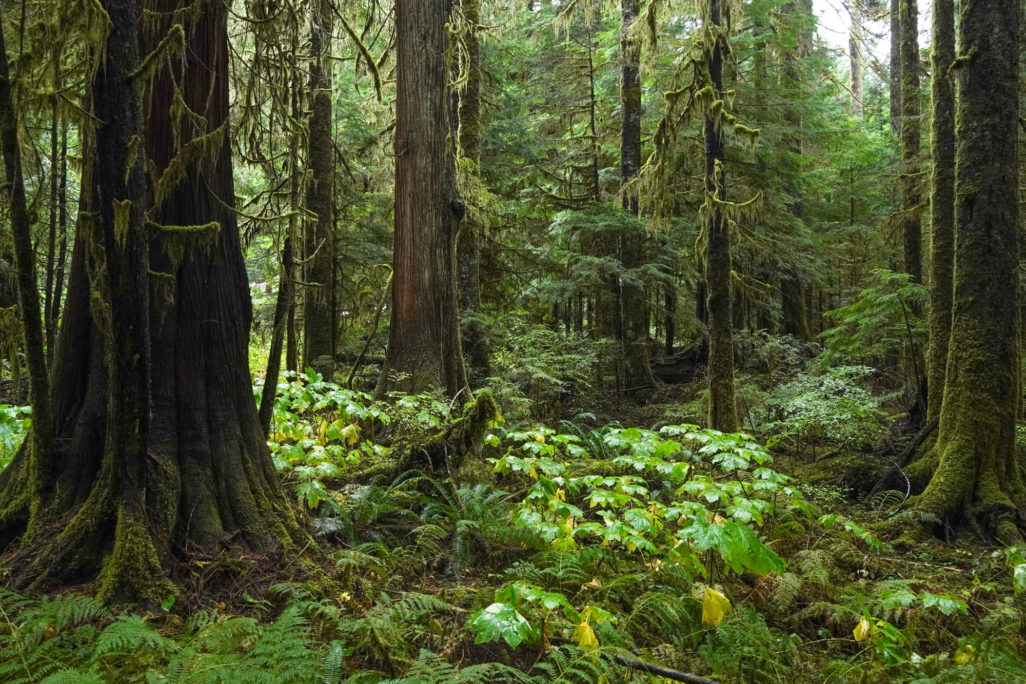
Members of the Fairy Creek Blockade occupy a logging road, preventing loggers for Teal-Jones timber company from moving into one of Vancouver Island’s last old-growth watersheds. Photo by Ken Dawson.
As logging resisters near month eight in Fairy Creek, a judge may order their surrender. Inside their last stand for old growth. A Tyee special report.
Simon Frankson emerged from his sleeping bag at 4 a.m., just in time to join the fray.
The day before, a balmy afternoon in early August, he and about a dozen campers had studied a satellite photo of the area: a mountainside sheathed in deep green cedars and Douglas fir trees, many of them hundreds or thousands of years old, in a watershed known as Fairy Creek in the southwest corner of Vancouver Island. The telling grey stripe of a logging road was creeping up from the left side of the image. It was the same kind of road that has, over the past century, made way for logging companies to cut down 80 per cent of the ancient forest on an island larger than Belgium.
When Frankson and the campers had arrived the night before, things already looked different than in the photo. The stripe had grown into a web of roads advancing up and across the slope. One more day and the machines could crest the ridge above them, opening up yet another valley to industrial logging.
Now Frankson was rubbing the sleep from his eyes and readying himself for his first shift as an old-growth forest blockader. Out of the blackness, the harsh headlights of a four-by-four came swerving around a switchback toward the camp. Frankson jumped up to join the line of bodies rushing to stand their ground. The driver, a contractor for the Teal-Jones timber company, killed the gas. For two long minutes, they faced one another, frozen. Then, as if concluding an unspoken conversation, the truck slowly reversed down the mountain.

The Fairy Creek blockaders, about a dozen to start, arrived in August and have stayed throughout the winter. ‘The point of the blockade,’ says activist Will O’Connell, ‘is not to wait for the non-profits, and not to let them keep leading us.’ Photo by Will O’Connell.
Now an injunction application by Teal-Jones threatens to break what’s been building over the past eight months. On April 1, the B.C. Supreme Court will decide whether to grant the injunction and authorize arrests. But the blockaders have already declared a “last stand for ancient temperate rainforests” no matter the costs.
In a world wracked by climate change and species loss, the Fairy Creek blockaders occupy a desperate frontline. But like the speed of industrial logging, slap-dash movements like this one have consequences. Urgency saves trees but it can alienate allies. While environmentalists are making more effort to work with local First Nations that share similar goals, Fairy Creek is a reminder that it’s not always easy. Pacheedaht First Nation, whose territory includes the watershed, has long relied on old-growth logging. But the nation is at a crossroads when it comes to the future of its forests.
The blockaders are racing not only to stymie the plans of Teal-Jones, but to forge deeper connections with potential new allies. It’s not clear what Friday’s showdown in court will set in motion. Will an injunction scatter the blockaders? Or might it accomplish what they hope — a heightened awareness of their fight, catalyzing the kind of broad, even international, support that fuelled British Columbia’s previous War in the Woods?
The initial calls to defend Fairy Creek came via email and Zoom from a 17-year-old in Union, Wash. named Joshua Wright, who grew up visiting the cedar and hemlock groves of Vancouver Island as a kid.
The blockade came together in days, but it was a response to decades of government inertia when it comes to protecting old-growth forests. Despite promises to implement recommendations of a 2020 report that advises deferred logging in the most at-risk forest ecosystems within six months, the NDP government has failed to make any concrete changes.
The dirt road to Fairy Creek’s Ridge Camp shows the scars of this inaction. Clearcuts — large areas of forest razed for timber — create a camo-print collage that stretches across the territory of Pacheedaht First Nation toward the small town of Port Renfrew, two hours northwest of Victoria up a winding coastal road. Old-growth logging is happening all around here, but the blockade has mainly kept its focus on the 2,000 hectares of rainforest around Fairy Creek, a tributary of the San Juan River. It’s the largest swath of unbroken old-growth forest in the region outside of a park.

The forest near River Camp in the Fairy Creek watershed. Photo by Serena Renner.
“Old growth” is a simple term for complex ecosystems that have evolved over long periods of time and are home to thousands, if not millions, of plant and animal species. Their multi-storied canopies are often compared to cathedrals for the way they filter light between columns of trees that range from saplings to prehistoric giants. The province’s definition for coastal old growth is a forest containing trees more than 250-years-old.
Coastal temperate rainforests, like the moss-laden landscapes of Vancouver Island, cover less than one per cent of the planet. They purify air and water; shelter salmon, cedar and medicines integral to First Nations; and cool down regional climates by producing a near constant drizzle. The most biologically productive of these forests — those with the greatest variety of species and largest trees — gulp and store more carbon than any other above-ground environment. Their structure and diversity also means they’re less vulnerable to fires, floods and natural disturbances. In other words, they’re one of our best defences in the fight against global climate change.
B.C., though, has historically depended on old-growth logging, which took off on Vancouver Island around the 1920s and was the economic backbone of towns like Port Renfrew. Half a century later, industrial-scale forestry galvanized a wave of opposition. In the early 1980s, Indigenous communities and environmentalists began to recognize the scale of losses and set up Canada’s first logging blockade on Meares Island, a 30-minute boat ride from Tofino in Clayoquot Sound, Tla-o-qui-aht territory. The effort, which combined direct action with Indigenous court cases, led to the protection of Meares Island in 1985.
But the clear cutting continued. By the early 1990s, just 30 per cent of the Island’s original forest and a fraction of its watersheds remained unlogged. Roadblocks, tree sits and encampments spread across the Island, culminating in 1993 with the Clayoquot Sound protests that came to be known as the War in the Woods. Nearly 900 people were arrested that summer. It’s still considered one of the largest acts of nonviolent civil disobedience in Canadian history.
Yet today, the Island is down to 20 per cent of its original ancient forest. And only around three per cent of that is estimated to be the most productive valley bottoms with the biggest, oldest trees.
“I couldn’t believe we were still logging old growth,” says blockader Shawna Knight. “At the rate that resource extraction happens in B.C., if we don’t stand up and do something right now, there will be nothing left.”
(Read the full story, published March 25 2021, at The Tyee. The feature was republished by The Star Vancouver and The Narwhal).